Strategies for Learning Mathematics
| ✅ Paper Type: Free Essay | ✅ Subject: Education |
| ✅ Wordcount: 3364 words | ✅ Published: 18 Jun 2018 |
Introduction:
This essay focusses on assessing and monitoring the progress of learners using different strategies during the period of ten lessons focussing on two units of mathematics. School ‘X’ has structured assessment for learning, every lesson is designed in a way that every student is assessed in different ways. The research is focussed on year 7 “mathematics lesson”. This class is set 2 mostly high ability students however few students should be achieving their targets. Gould and Roffey-Barentsen (2014) provide a useful definition of assessment as having a key role in the planning process as well as delivery of teaching. Assessment serves a number of important uses in that it helps consolidate and check learning as well as providing feedback to those who require it. My school expects me to use a vast number of assessments when teaching. We use many forms of assessment such as, initial, diagnostic, formative, and/or summative to be able to deliver inclusive teaching and learning.
I have selected two units 1) surface area and volume of prisms and 2) Ratios and proportions. The purpose of unit 1 is to help students extend their knowledge of area, perimeter, and volume to include surface area. The major goals NCTM proposes are for students to understand quantifiable characteristics of objects and the units, systems, and procedures of measurement. The purpose of unit 2 is that the concepts of ratio and proportionate fundamental to mathematics and important in many other fields of knowledge. Many phenomena can be expressed as some proportional relationship between specific variables (Chaim,Keret,llany, 2012).
Literature Review:
Monitoring is the skill of effectively overviewing and analysing a learning situation (Headington, 2000). In school’s context, professional monitoring systems (Tymms 1999) exist in parallel with the monitoring of learning in the classroom. Assessment is the closer examination of pupils learning (Headington, 2000). It is reporting as a central issue in teaching and learning throughout education as it lacks consistency primarily due to each teacher within the school has adapted a different method of assessment and this is what makes one teacher a good and another poor. In England, since 1988 Education reform act national testing has taken central stage in monitoring standards in schools (Capel, 2009). Assessment for learning is ‘Any assessment for which the first priority is to serve the purpose of promoting students learning'(Black et al, 2003) . AFL aims to ‘close the gap’ between a student’s present situation and where they want to be in their knowledge and attainment. Accomplished teachers plan tasks which support learners to do achieve their targets.
Since 2002 there has been an obvious inclination in some assessment strategy reports in the UK to study alternatives to using external exams for summative valuation of pupils ‘performance. Several research studies have shown that the use of assessment to develop pupils future learning makes a substantial difference, not just to pupils’ attainment, but to their attitude to learning, their engagement with school subjects and their motivation to do well in these subjects (Black and Wiliam 1998).
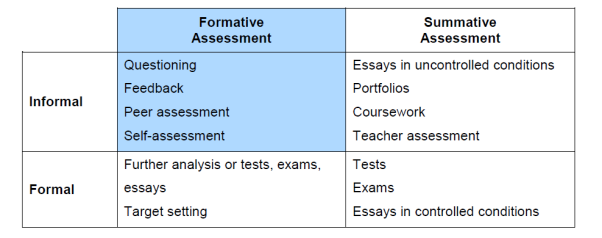
Formative Assessment
A key literature investigation of over 250 sources on formative assessment (Black and Wiliam 1998) found that effective assessment practices can play a influential role in the learning experience, moving an average student, for instance, to the top third of the class – but only if certain settings are satisfied. Student tasks required to be aligned, or on target,
with learning goals, and students need to obtain meaningful and appropriate response on their performance, as well as targeted follow-up work. To adjust their learning effectually, students need to understand three things: (a) the measures on which they will be judged, (b) where they stand on these measures, and (c) how they can improve (Black and Wiliam 1998, p. 143). Formative assessment has been thought of as providing teachers with more frequent evidence of students’ mastery of standards to help teachers make useful instructional decisions. In this way, formative assessment is intended to enhance student learning.
Research carried out by Balck and Wiliam, and also by projects such as Suffolk Advisory service (2001) into feedback and marking indicates that improving learning through formative learning depends on the following five key factors. These are:

Modelling Quality:
According to (Bourdillon and Storey, 2002) pupils are more successful when they know what they are learning. This means communicating clearly what the pupils will be learning and how they can recognise their success. Therefore, learning intentions can be shared with pupils through modelling and how learning objective is achieved. According to Lee (2006), objectives can be broken down into small steps called success criteria, therefore its easier for pupils to know what that need to achieve and they can measure it at the end of the lesson.

Questioning and dialogue with pupils:
Clarke(2005) gives a wide range of suggestions for varying the format of questions in classrooms as it is the quickest and easiest way to assess pupils. I have also developed skills in asking questions across the full range of Blooms taxonomy, from simple recall and comprehension to complex evaluative questioning. The key to success in developing fruitful channels of dialogue with pupils about their learning lies in creating a relaxed and trusting overall climate in the classroom, so that pupils are not afraid to answer, contribute to discussions and make public their thinking or volunteer their uncertainties to you and rest of the class (Clarke,2005). It is best to plan questioning strategy, for instant questions on prior learning to setup the major themes of the lesson, also to check learning and to reinforce learning that has taken place. It is also important to plan how questions will be asked, whether from the whole class, just one group or an individual. Sometimes teachers give no time to students to think and accepts answers from those who raise their hands, and some teachers use no hand policy and giving pupils thinking time (Brooks, Abbott, Bills, 2007).
Mini white boards:
Another formative assessment idea that engages the entire class and provides evidence of student learning is the white board. Teachers can quickly grasp student understanding and adjust how they move forward. According to Black and Wiliam (1998) teachers need to build in opportunities for pupils to express their understanding. Pupils benefit from opportunities of formal feedback through mini white boards, as this gives chance to pupils to express their knowledge and understanding and to articulate their thinking, and also misconceptions can be spotted straight away. The figure below shows how students learning can be assessed through mini white boards.
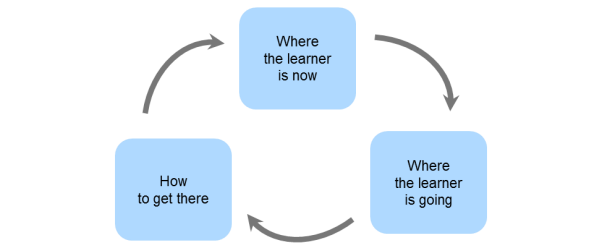
Dialogue and effective feedback through marking
According to the National Research Council report ”How People Learn” (Bransford et al. 2000), timely feedback and revision, on activities congruent with learning goals, is ”extremely important” for developing adaptive expertise, learning, transfer and development. Constructive feedback is vital in helping pupils to progress. Nevertheless, one review of the literature on feedback found that two out of every five feedback effects were negative (Black and Wiliam, 1998). According to Ofsted (1996) marking often fails to guide on how work can be improved, as the information about pupil’s performance received by the teacher is insufficiently used to inform subsequent work.
Target settings can address these difficulties, by taking a defect and converting into a target, offering guidance on how to improve. It has been found to increase pupils motivation and sense of purpose and accelerates rate of progress (Black and Wiliam, 1998). I will be marking books every two weeks, giving pupils targets and showing them example questions to help throug positive feedback on the things they have done well. Marking is guidance to pupils so that they can react upon provided feedback and the aim is for the student to reflect upon their mistakes and answer accurately so that adequate notes are made in their exercise books for revision, it must also include dialogue between the teacher and student so that informed feedback is provided which underlines pupil’s strengths. School ‘x’ has a strict book checks every three weeks which focuses on timely and constructive dialogue between teachers and pupils.
Self-assessment and understanding how to improve
Formative assessment achieves its full potential when pupils become engaged with the process through self-assessment. Pupils who become skilled in self-assessment make impressive learning gains. According to one study, pupils were trained to make regular self-assessment over20-week period and that group made double the progress of the group who were not trained for self-assessment. However, Black and wiliam have concluded that self-assessment is too difficult for pupil, unless they are trained in self-assessment and can understand its main purpose and reflect on their learning effectively. Throughout my lessons self-assessment was vital at the end of each lesson, showing what went well and even better if.
Summative assessment:
Preparing pupils for external exams and assessment has been an increasingly important part of the secondary teacher’s role. The purpose behind national external assessments has been clearly formulated, to identify individual achievements, strengths and weaknesses in order to help them in next stages, to enable parents to put their child’s attainment in context, to make available to public schools attainment and to help school evaluating their own teaching (Bourdillon and Storey, 2002) .
Case study and students’ progress:
My case study includes five students selected after observations and from discussions with my mentor, who I will assess. Their names are coded as Student E,F, G, H and I and in the table below I have mentioned why I would like to assess them during this course of study and check if by the end of the research they have achieved their targets.
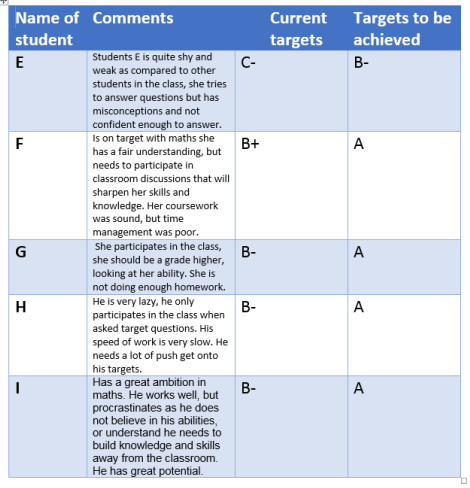
Table 1: Shows the description of students and their current and target grades
I have monitored throughout the course of 10 lessons of the above students when the learning outcome does not meet the learning objective for the class or groups or individuals. Such monitoring when analysed, can provide an insight into the teaching and learning which is taking place. The subject monitoring sheet for maths lessons (Figure 2) shows an example of this. The learning of the five targeted students was monitored for a course of two units against learning objectives drawn from national numeracy strategy. The monitoring was coded as follows:
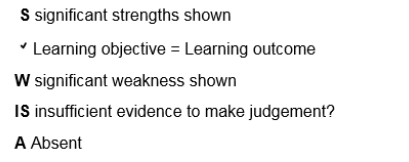

Figure 2: Subject monitoring sheet for maths
This data shows the results through the formative assessment I have collected. The research proves one of the best ways to check if pupils understanding is to ask questions. During my first few lessons, the typical response was same children continually have their hands up, and usually in order to elicit the right answers , teachers uses the right children, and I did the same in my first 2 lessons. From third lesson I changed my tactics and targeted students who were not participating in the class, or I used to wait for more hands up, and encouraged students to raise hands through E-praise. Student E is very shy, she was reluctant in the beginning to answer, but I encouraged and praised her to answer, since then I can see her raising hands for not all questions but some
Students E, F and H has shown significant improvement during target questioning, they were more attentive and responsive. Setting a routine of target questioning resulted in pupils raising their hands up without asking. I cultivated the classroom atmosphere where more and more pupils are prepared to open up and share their thinking about their uncertainties. To accomplish this approach requires full sensitivity, knowledge of your pupils, first-rate interpersonal skills as well as perceptiveness in formulating adroitly posed questions.
In my practice, I always start with open end questions to give students a chance to think and then I try to develop a structure in their mind through these questions and then moving on to close end questions to scaffold their understanding. Target questioning helped me to clear misconceptions throughout my lessons.
Refereeing to all my lessons, I have used mini white boards instantly in each lesson, introduce a topic, show them at least two questions and then check their understanding on the mini white boards, I get instant feedback from every child. They aren’t broadcasting that they think they don’t understand something, they give me an actual mathematical answer from which I judge the accuracy and target the misconceptions. It is more subtle than directly admitting you can’t do something in front of your peers. They allow algebraic answers just as easily as numerical or wordy ones. You know which kids to differentiate for at both ends. For example student E and H along with some other students showed weakness understanding the concept of surface area of prisms, and picked it up their misconceptions through mini white board activity, it was mostly to do with area of a triangle. Therefore, The next lesson I did a revision lesson on same topic so that all misconceptions were cleared, and in lesson 3, both student E and H showed significant strengths. Similarly in lesson 8, student G showed weakness, which I assessed during white board activity and I made sure that student G understands it properly, as I probed targeted questions throughout lesson.
This data also helped me to mark students work, so that I can compare the assessment I performed during class through mini white boards and questioning is correct or not. I marked students work and homework. Homework in school ‘x’ is given twice a week to each year group. According to Ofsted, marking reinforces underachievement and under expectation be being too generous or unfocused. Therefore, I marked with feedback on each mistake as shown in the example below. I modelled the incorrect questions step by step and asked them to do it again.
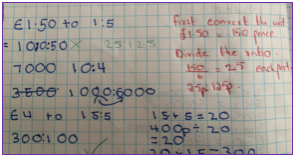
I also made homework spreadsheet, which showed me exactly how many questions students attempted were correct as shown in table below.
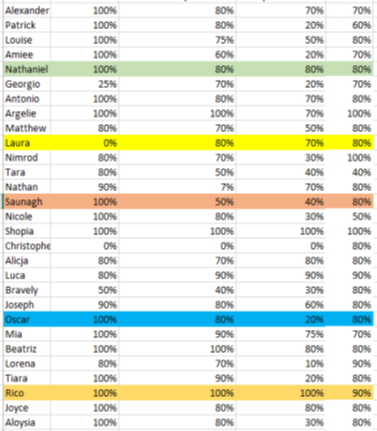
Table 3: Shows the percentage of correct answers students did in each homework.
This table helped me to understand pupil’s misconceptions and therefore, I gave questions as starter which I saw were most difficult. I also followed student’s homework by rechecking if they have corrected the mistakes in the following lesson, as the list provided me clear instructions which student’s book I have to check. By following this routine, Student G made remarkable change in providing her homework with full potential. The class slowly developed the routine of teacher and student dialogue, by making students aware that if I have made any comments, its student’s responsibility to check it and comment on it, and if the comment is about redoing the questions than it has to be done again. It can be noticed from the table that student’s homework percentage got better each week.
Year 7’s were not aware of self-assessment, therefore I briefed them with three key points with:

During my first three lessons I used the slide given below, by giving them examples of how they can think and evaluate their learning. Students were questioned to summarize the learning objectives and success criteria before they embark on the task.
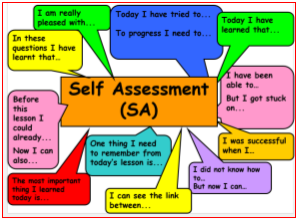
From lesson four, when people were confident I used the slide below to make them think themselves without giving the example. Students F, H and I books showed clear evidence that they were honest about their reflection and were trying in the next lesson to make their learning better. Figure 6 and 7 shows some examples of pupil’s reflection
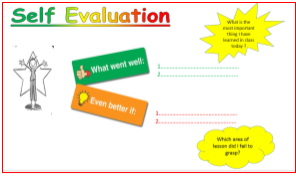


Summative assessment was done by unit test after each unit. Before each unit test, a revision lesson was run to clear the misconceptions as the books were marked before the revision to check students understanding, their homework’s and self-assessment. After each unit test, teacher marked the test and made two comments on what students did well at, and two comments what they need to improve on. As shown in the picture 9 below. Students evaluated their performance in the yellow sheets provided by teacher, on their strengths and on action points.
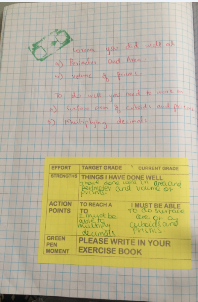
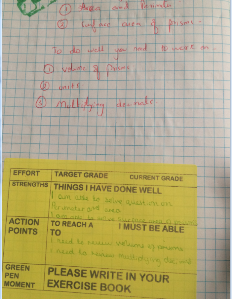
A spreadsheet was also created for each question, which helped me to create green pen questions for students and to check which part of unit test students found most difficult, as shown below in table 7.


Green pen questions were prepared by teacher, and were allocated to each student according to the action points as illustrated in the figures below of student E and H. These action questions helps them again to reflect on their mistakes and improve their mistakes.

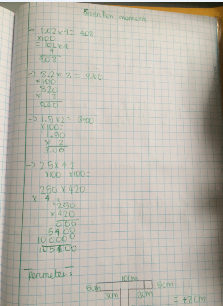
The summative assessment results after two unit test I performed with year 7’s are shown below which has shown significant improvement in their grades from previous grades, that they have moved a grade higher from their previous targets.
Analysis:
Analysing the sequence of lessons and assessments methods used during the period of 10 lessons, assessing through questioning and mini white board activity showed very good results as , it showed me clearly students misconceptions and cultivated the culture of engaging and thinking before answering, but when I marked their books, I saw some very obvious mistakes repeated which I pointed during mini white board activity. There is a potential risk of students copy the answers from peers just of the fear of getting pointed for mistakes and they are hesitant to ask questions. Therefore, mini white board activity is a very effective way to assess students understanding and it has shown a tremendous effectivity during all my lessons as it enables to test the depth of students understanding but it is not 100 percent accurate as students sometimes tend to copy from their peers, if they were targeted and the answer was wrong, they potentially can copy answer of next question from their peers to avoid embracement. It is the same case in questioning, mostly gifted students answer questions. Targeted questions help to encourage students to answer questions, as through diagnostic assessments and marking books, teachers knows which student to target. But if the culture of questioning and use of mini white boards remain there, it will help students to try harder and remain attentive throughout lessons.
Assessing through marking books gives a very clear idea that how much progress student has made in the class and by doing their homework. Spread sheet of homework helped me and I asked some students to come during break time to clear their misconceptions, I also ran revision lessons where I cleared those concepts and did target questions from less progressing pupils through marking books. During marking books I started a dialogue with students, for example “how this question can be made better” and by giving them model answers, as soon as pupils got their books back they had to comment on their mistakes, which helped in building an environment of student’s teacher’s dialogue.
Similarly self-reflection helped students to start thinking about their strengths and weaknesses and it consolidates their learning more. In each lesson they commented about something to improve and what they did well at, it improved the sequence of learning and each lesson showed evident improvement. Since year 7’s started to reflect on their learning during my teaching, it is still very confusing for some students what to write but I still encourage them to summarize their learning objective and think before writing.
Finally the summative assessment triangulates the research, Students E,F,G,H and I have made tremendous effort through these weeks and shown that through these assessment’s they have already reached their targets.
References
Headington, Rita. (2000). Monitoring, assessment, recording, reporting and accountability. London: David Fulton, 8,9
Last name, First initial. (Year published). Title. Edition. (Only include the edition if it is not the first edition) City published: Publisher, Page(s).
Gould, Jimm. And Roffey, Jodi. (2014). Achieving your Diploma in Education and Training. Sage publications ltd.
Chaim, Keret, IIany, David, Yaffa, Bat-Sheva. (2012). Ratio and proportion. Rotterdam: Sense Publishers, 1.
Cambridge-Community. Getting started with assessment for learning. [online] Available at: URL [http://www.cambridge-community.org.uk/professional-development/gswafl/index.html]
Black, P. and Wiliam, D. (1998). ‘Inside the black box: Raising standards through classroom assessment’, Phi Delta Kappan 80(2), 139-148.
Bransford, J.D., Brown, A.L. and Cocking (2000). The Design of Learning Environments: Assessment-Centered Environments. How People Learn: Brain, Mind, Experience, and School. Washington, DC, National Academy Press, pp. 131-154.
Wilson, M. & Scalise, K. 2006, “Assessment to Improve Learning in Higher Education: The BEAR Assessment System”, Higher Education, vol. 52, no. 4, pp. 635-663.
Stiggins, R. 2005, “From Formative Assessment to Assessment for Learning: A Path to Success in Standards-Based Schools”, The Phi Delta Kappan, vol. 87, no. 4, pp. 324-328
Cite This Work
To export a reference to this article please select a referencing stye below:
Related Services
View allDMCA / Removal Request
If you are the original writer of this essay and no longer wish to have your work published on UKEssays.com then please click the following link to email our support team:
Request essay removal


